Euthanasia, Right to Die: Legal and Social Implications
VerifiedAdded on 2022/08/12
|7
|1592
|11
Essay
AI Summary
This essay provides a comprehensive overview of euthanasia and the right to die, exploring its historical context, ethical considerations, and legal implications. It begins with an introduction to the debate, highlighting arguments for and against the practice, and then delves into the history of euthanasia, tracing its evolution from early practices to the modern era. The essay examines the practice of euthanasia in different countries, such as the Netherlands and Thailand, analyzing the legal frameworks and social attitudes surrounding it. It also discusses social movements related to the right to die, focusing on the influence of religious institutions and the development of ethical doctrines. The essay concludes by emphasizing the need for solutions to healthcare system issues and the importance of considering passive euthanasia. The essay draws on scholarly articles to support its arguments and provide a nuanced understanding of this complex issue. The essay is contributed by a student to be published on the website Desklib. Desklib is a platform which provides all the necessary AI based study tools for students.
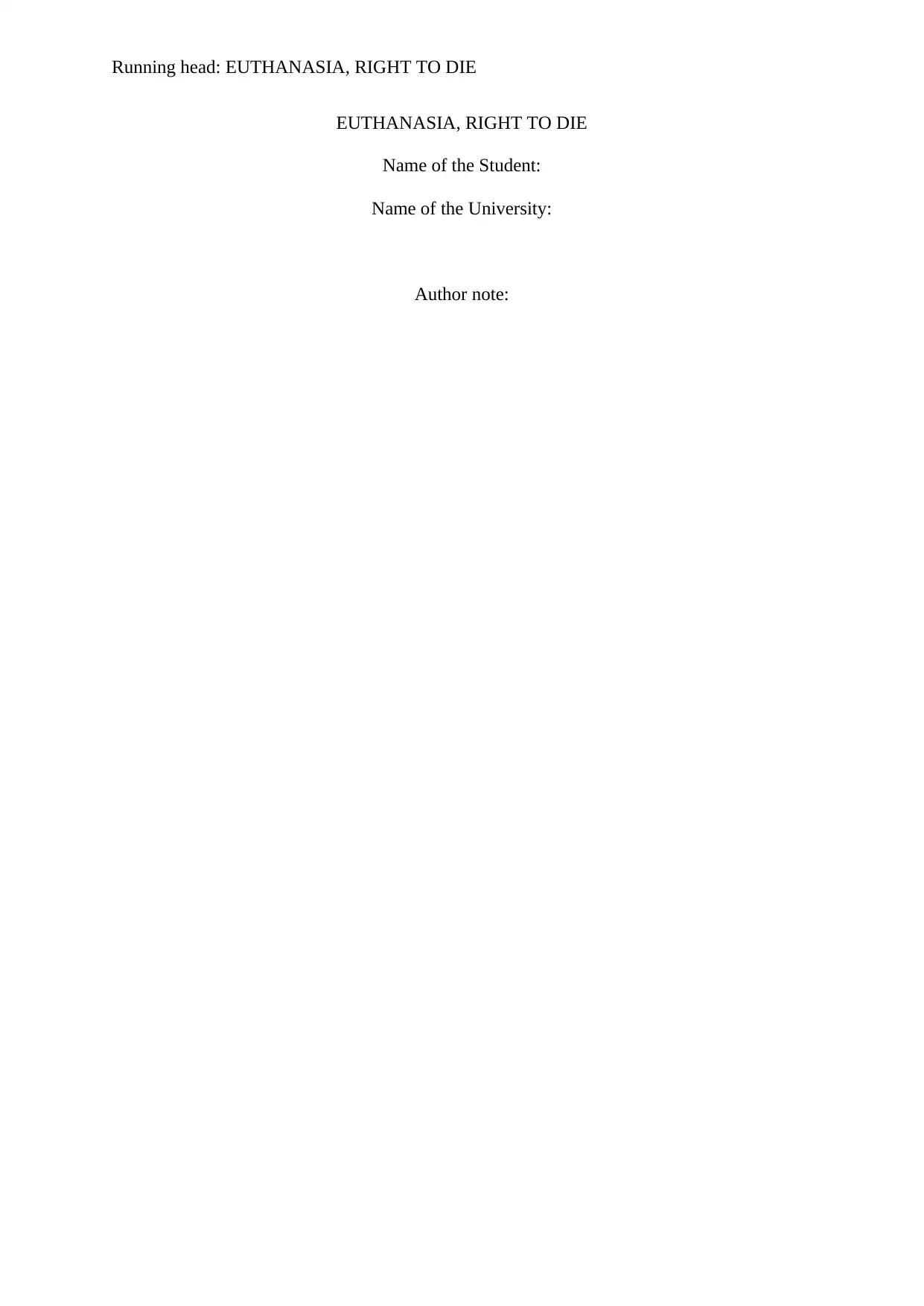
Running head: EUTHANASIA, RIGHT TO DIE
EUTHANASIA, RIGHT TO DIE
Name of the Student:
Name of the University:
Author note:
EUTHANASIA, RIGHT TO DIE
Name of the Student:
Name of the University:
Author note:
Paraphrase This Document
Need a fresh take? Get an instant paraphrase of this document with our AI Paraphraser
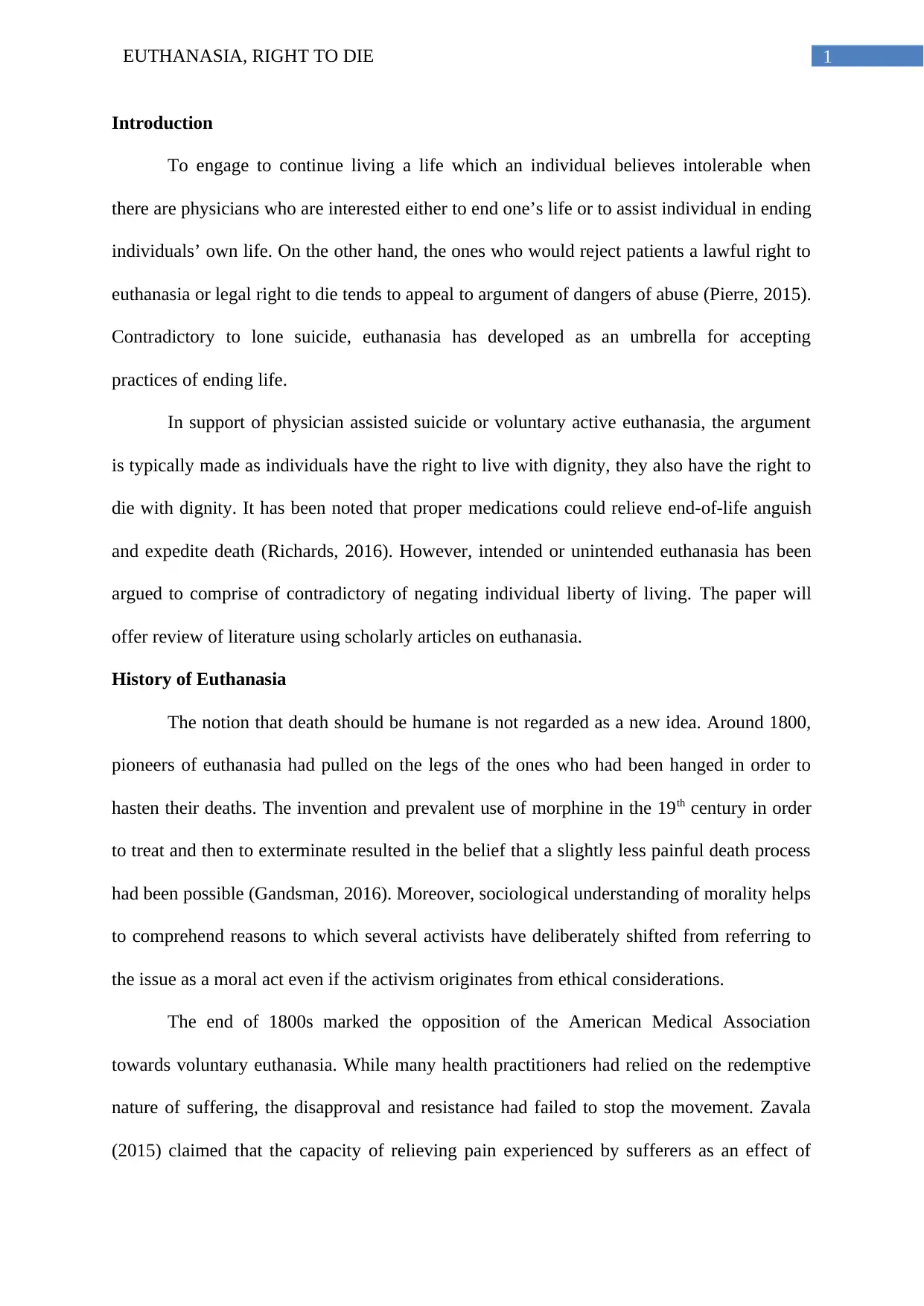
1EUTHANASIA, RIGHT TO DIE
Introduction
To engage to continue living a life which an individual believes intolerable when
there are physicians who are interested either to end one’s life or to assist individual in ending
individuals’ own life. On the other hand, the ones who would reject patients a lawful right to
euthanasia or legal right to die tends to appeal to argument of dangers of abuse (Pierre, 2015).
Contradictory to lone suicide, euthanasia has developed as an umbrella for accepting
practices of ending life.
In support of physician assisted suicide or voluntary active euthanasia, the argument
is typically made as individuals have the right to live with dignity, they also have the right to
die with dignity. It has been noted that proper medications could relieve end-of-life anguish
and expedite death (Richards, 2016). However, intended or unintended euthanasia has been
argued to comprise of contradictory of negating individual liberty of living. The paper will
offer review of literature using scholarly articles on euthanasia.
History of Euthanasia
The notion that death should be humane is not regarded as a new idea. Around 1800,
pioneers of euthanasia had pulled on the legs of the ones who had been hanged in order to
hasten their deaths. The invention and prevalent use of morphine in the 19th century in order
to treat and then to exterminate resulted in the belief that a slightly less painful death process
had been possible (Gandsman, 2016). Moreover, sociological understanding of morality helps
to comprehend reasons to which several activists have deliberately shifted from referring to
the issue as a moral act even if the activism originates from ethical considerations.
The end of 1800s marked the opposition of the American Medical Association
towards voluntary euthanasia. While many health practitioners had relied on the redemptive
nature of suffering, the disapproval and resistance had failed to stop the movement. Zavala
(2015) claimed that the capacity of relieving pain experienced by sufferers as an effect of
Introduction
To engage to continue living a life which an individual believes intolerable when
there are physicians who are interested either to end one’s life or to assist individual in ending
individuals’ own life. On the other hand, the ones who would reject patients a lawful right to
euthanasia or legal right to die tends to appeal to argument of dangers of abuse (Pierre, 2015).
Contradictory to lone suicide, euthanasia has developed as an umbrella for accepting
practices of ending life.
In support of physician assisted suicide or voluntary active euthanasia, the argument
is typically made as individuals have the right to live with dignity, they also have the right to
die with dignity. It has been noted that proper medications could relieve end-of-life anguish
and expedite death (Richards, 2016). However, intended or unintended euthanasia has been
argued to comprise of contradictory of negating individual liberty of living. The paper will
offer review of literature using scholarly articles on euthanasia.
History of Euthanasia
The notion that death should be humane is not regarded as a new idea. Around 1800,
pioneers of euthanasia had pulled on the legs of the ones who had been hanged in order to
hasten their deaths. The invention and prevalent use of morphine in the 19th century in order
to treat and then to exterminate resulted in the belief that a slightly less painful death process
had been possible (Gandsman, 2016). Moreover, sociological understanding of morality helps
to comprehend reasons to which several activists have deliberately shifted from referring to
the issue as a moral act even if the activism originates from ethical considerations.
The end of 1800s marked the opposition of the American Medical Association
towards voluntary euthanasia. While many health practitioners had relied on the redemptive
nature of suffering, the disapproval and resistance had failed to stop the movement. Zavala
(2015) claimed that the capacity of relieving pain experienced by sufferers as an effect of
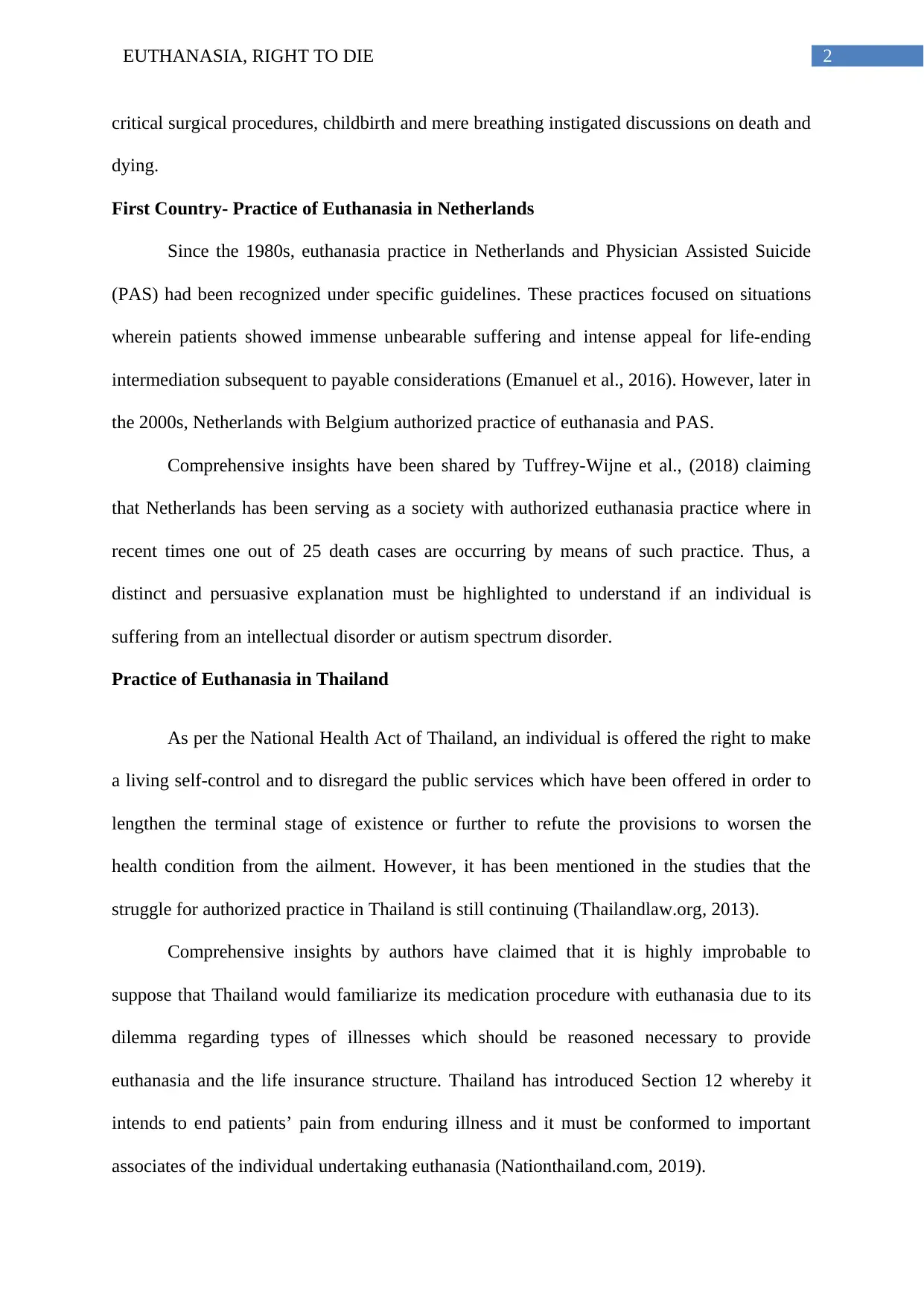
2EUTHANASIA, RIGHT TO DIE
critical surgical procedures, childbirth and mere breathing instigated discussions on death and
dying.
First Country- Practice of Euthanasia in Netherlands
Since the 1980s, euthanasia practice in Netherlands and Physician Assisted Suicide
(PAS) had been recognized under specific guidelines. These practices focused on situations
wherein patients showed immense unbearable suffering and intense appeal for life-ending
intermediation subsequent to payable considerations (Emanuel et al., 2016). However, later in
the 2000s, Netherlands with Belgium authorized practice of euthanasia and PAS.
Comprehensive insights have been shared by Tuffrey-Wijne et al., (2018) claiming
that Netherlands has been serving as a society with authorized euthanasia practice where in
recent times one out of 25 death cases are occurring by means of such practice. Thus, a
distinct and persuasive explanation must be highlighted to understand if an individual is
suffering from an intellectual disorder or autism spectrum disorder.
Practice of Euthanasia in Thailand
As per the National Health Act of Thailand, an individual is offered the right to make
a living self-control and to disregard the public services which have been offered in order to
lengthen the terminal stage of existence or further to refute the provisions to worsen the
health condition from the ailment. However, it has been mentioned in the studies that the
struggle for authorized practice in Thailand is still continuing (Thailandlaw.org, 2013).
Comprehensive insights by authors have claimed that it is highly improbable to
suppose that Thailand would familiarize its medication procedure with euthanasia due to its
dilemma regarding types of illnesses which should be reasoned necessary to provide
euthanasia and the life insurance structure. Thailand has introduced Section 12 whereby it
intends to end patients’ pain from enduring illness and it must be conformed to important
associates of the individual undertaking euthanasia (Nationthailand.com, 2019).
critical surgical procedures, childbirth and mere breathing instigated discussions on death and
dying.
First Country- Practice of Euthanasia in Netherlands
Since the 1980s, euthanasia practice in Netherlands and Physician Assisted Suicide
(PAS) had been recognized under specific guidelines. These practices focused on situations
wherein patients showed immense unbearable suffering and intense appeal for life-ending
intermediation subsequent to payable considerations (Emanuel et al., 2016). However, later in
the 2000s, Netherlands with Belgium authorized practice of euthanasia and PAS.
Comprehensive insights have been shared by Tuffrey-Wijne et al., (2018) claiming
that Netherlands has been serving as a society with authorized euthanasia practice where in
recent times one out of 25 death cases are occurring by means of such practice. Thus, a
distinct and persuasive explanation must be highlighted to understand if an individual is
suffering from an intellectual disorder or autism spectrum disorder.
Practice of Euthanasia in Thailand
As per the National Health Act of Thailand, an individual is offered the right to make
a living self-control and to disregard the public services which have been offered in order to
lengthen the terminal stage of existence or further to refute the provisions to worsen the
health condition from the ailment. However, it has been mentioned in the studies that the
struggle for authorized practice in Thailand is still continuing (Thailandlaw.org, 2013).
Comprehensive insights by authors have claimed that it is highly improbable to
suppose that Thailand would familiarize its medication procedure with euthanasia due to its
dilemma regarding types of illnesses which should be reasoned necessary to provide
euthanasia and the life insurance structure. Thailand has introduced Section 12 whereby it
intends to end patients’ pain from enduring illness and it must be conformed to important
associates of the individual undertaking euthanasia (Nationthailand.com, 2019).
⊘ This is a preview!⊘
Do you want full access?
Subscribe today to unlock all pages.

Trusted by 1+ million students worldwide
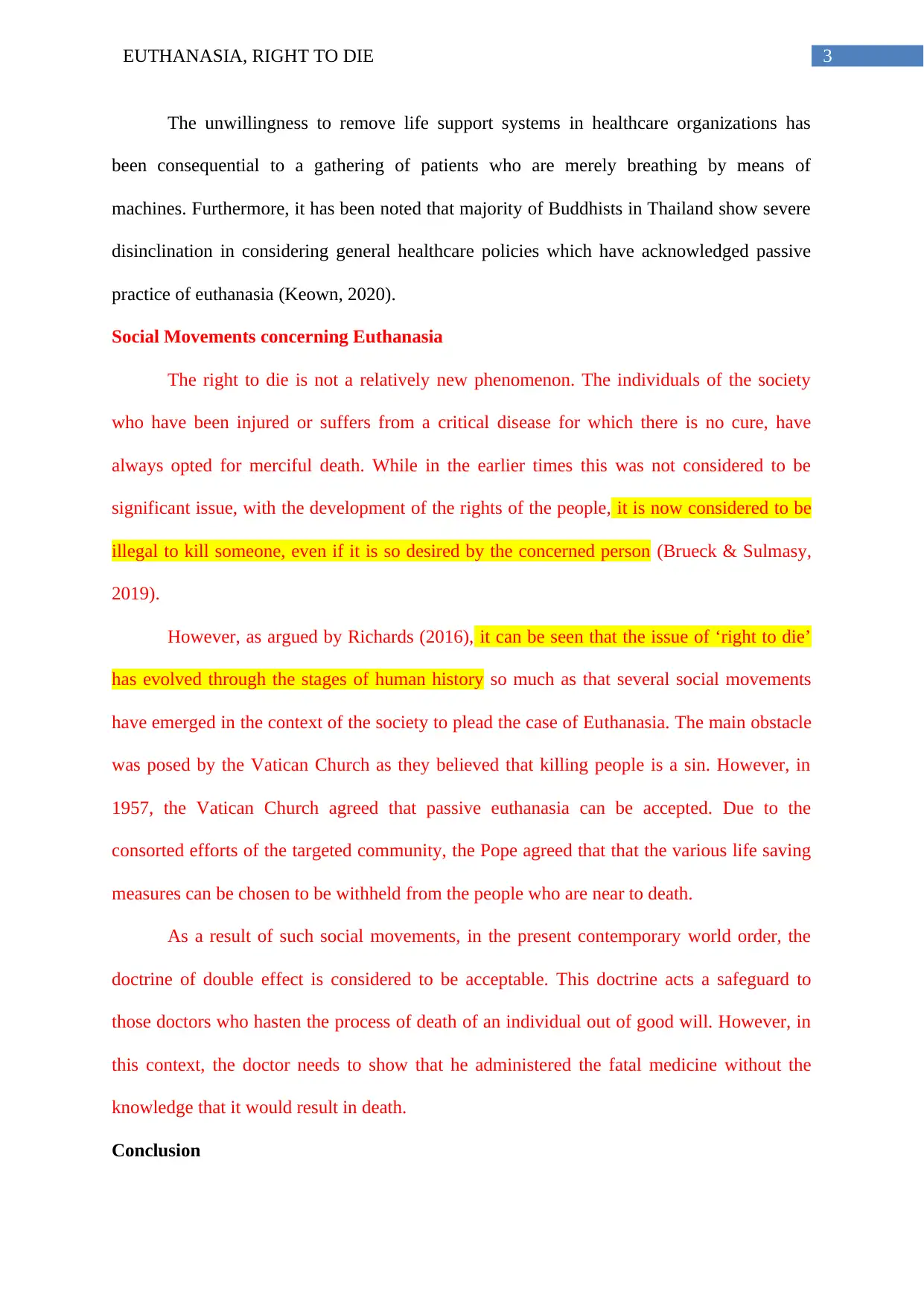
3EUTHANASIA, RIGHT TO DIE
The unwillingness to remove life support systems in healthcare organizations has
been consequential to a gathering of patients who are merely breathing by means of
machines. Furthermore, it has been noted that majority of Buddhists in Thailand show severe
disinclination in considering general healthcare policies which have acknowledged passive
practice of euthanasia (Keown, 2020).
Social Movements concerning Euthanasia
The right to die is not a relatively new phenomenon. The individuals of the society
who have been injured or suffers from a critical disease for which there is no cure, have
always opted for merciful death. While in the earlier times this was not considered to be
significant issue, with the development of the rights of the people, it is now considered to be
illegal to kill someone, even if it is so desired by the concerned person (Brueck & Sulmasy,
2019).
However, as argued by Richards (2016), it can be seen that the issue of ‘right to die’
has evolved through the stages of human history so much as that several social movements
have emerged in the context of the society to plead the case of Euthanasia. The main obstacle
was posed by the Vatican Church as they believed that killing people is a sin. However, in
1957, the Vatican Church agreed that passive euthanasia can be accepted. Due to the
consorted efforts of the targeted community, the Pope agreed that that the various life saving
measures can be chosen to be withheld from the people who are near to death.
As a result of such social movements, in the present contemporary world order, the
doctrine of double effect is considered to be acceptable. This doctrine acts a safeguard to
those doctors who hasten the process of death of an individual out of good will. However, in
this context, the doctor needs to show that he administered the fatal medicine without the
knowledge that it would result in death.
Conclusion
The unwillingness to remove life support systems in healthcare organizations has
been consequential to a gathering of patients who are merely breathing by means of
machines. Furthermore, it has been noted that majority of Buddhists in Thailand show severe
disinclination in considering general healthcare policies which have acknowledged passive
practice of euthanasia (Keown, 2020).
Social Movements concerning Euthanasia
The right to die is not a relatively new phenomenon. The individuals of the society
who have been injured or suffers from a critical disease for which there is no cure, have
always opted for merciful death. While in the earlier times this was not considered to be
significant issue, with the development of the rights of the people, it is now considered to be
illegal to kill someone, even if it is so desired by the concerned person (Brueck & Sulmasy,
2019).
However, as argued by Richards (2016), it can be seen that the issue of ‘right to die’
has evolved through the stages of human history so much as that several social movements
have emerged in the context of the society to plead the case of Euthanasia. The main obstacle
was posed by the Vatican Church as they believed that killing people is a sin. However, in
1957, the Vatican Church agreed that passive euthanasia can be accepted. Due to the
consorted efforts of the targeted community, the Pope agreed that that the various life saving
measures can be chosen to be withheld from the people who are near to death.
As a result of such social movements, in the present contemporary world order, the
doctrine of double effect is considered to be acceptable. This doctrine acts a safeguard to
those doctors who hasten the process of death of an individual out of good will. However, in
this context, the doctor needs to show that he administered the fatal medicine without the
knowledge that it would result in death.
Conclusion
Paraphrase This Document
Need a fresh take? Get an instant paraphrase of this document with our AI Paraphraser
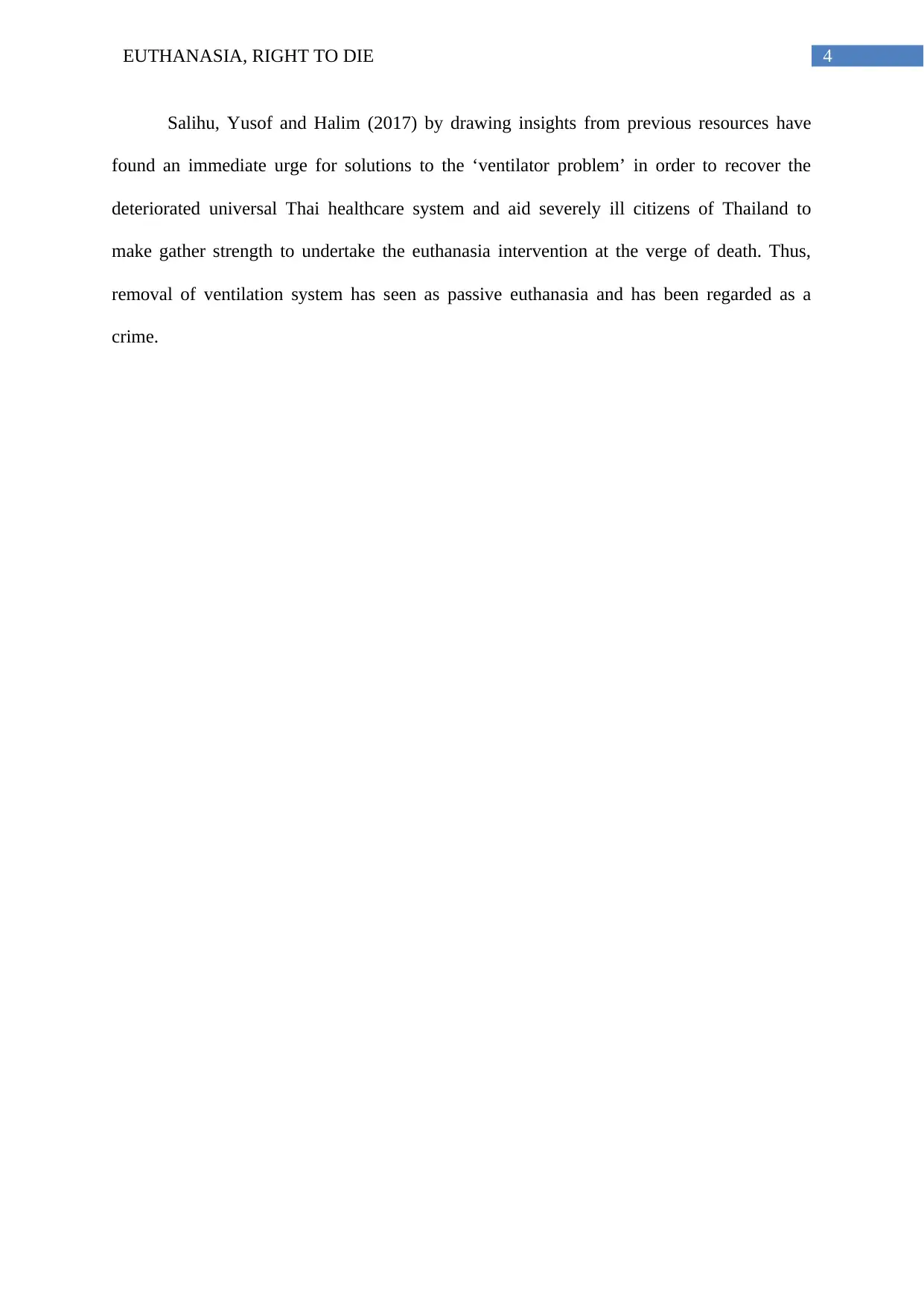
4EUTHANASIA, RIGHT TO DIE
Salihu, Yusof and Halim (2017) by drawing insights from previous resources have
found an immediate urge for solutions to the ‘ventilator problem’ in order to recover the
deteriorated universal Thai healthcare system and aid severely ill citizens of Thailand to
make gather strength to undertake the euthanasia intervention at the verge of death. Thus,
removal of ventilation system has seen as passive euthanasia and has been regarded as a
crime.
Salihu, Yusof and Halim (2017) by drawing insights from previous resources have
found an immediate urge for solutions to the ‘ventilator problem’ in order to recover the
deteriorated universal Thai healthcare system and aid severely ill citizens of Thailand to
make gather strength to undertake the euthanasia intervention at the verge of death. Thus,
removal of ventilation system has seen as passive euthanasia and has been regarded as a
crime.
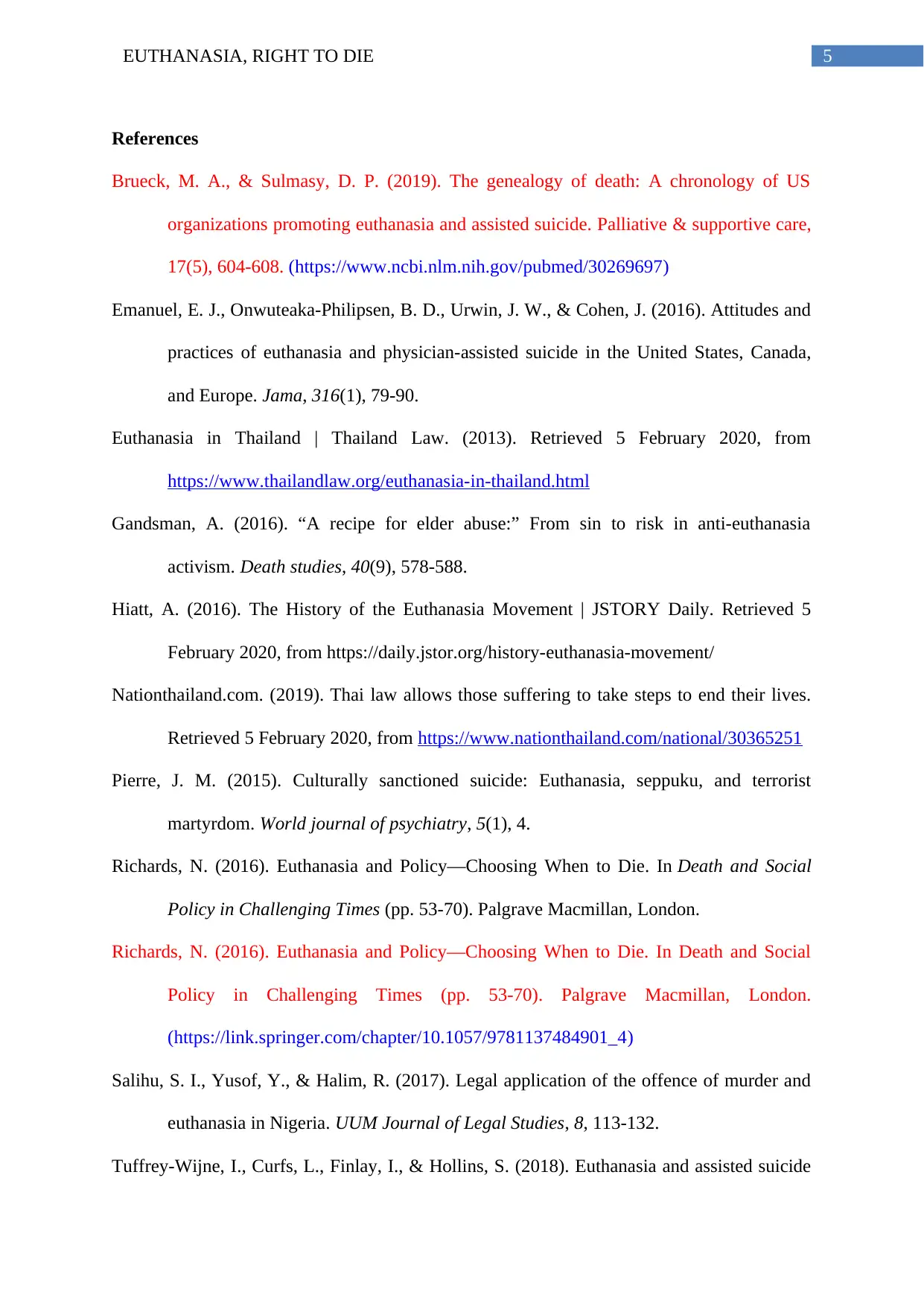
5EUTHANASIA, RIGHT TO DIE
References
Brueck, M. A., & Sulmasy, D. P. (2019). The genealogy of death: A chronology of US
organizations promoting euthanasia and assisted suicide. Palliative & supportive care,
17(5), 604-608. (https://www.ncbi.nlm.nih.gov/pubmed/30269697)
Emanuel, E. J., Onwuteaka-Philipsen, B. D., Urwin, J. W., & Cohen, J. (2016). Attitudes and
practices of euthanasia and physician-assisted suicide in the United States, Canada,
and Europe. Jama, 316(1), 79-90.
Euthanasia in Thailand | Thailand Law. (2013). Retrieved 5 February 2020, from
https://www.thailandlaw.org/euthanasia-in-thailand.html
Gandsman, A. (2016). “A recipe for elder abuse:” From sin to risk in anti-euthanasia
activism. Death studies, 40(9), 578-588.
Hiatt, A. (2016). The History of the Euthanasia Movement | JSTORY Daily. Retrieved 5
February 2020, from https://daily.jstor.org/history-euthanasia-movement/
Nationthailand.com. (2019). Thai law allows those suffering to take steps to end their lives.
Retrieved 5 February 2020, from https://www.nationthailand.com/national/30365251
Pierre, J. M. (2015). Culturally sanctioned suicide: Euthanasia, seppuku, and terrorist
martyrdom. World journal of psychiatry, 5(1), 4.
Richards, N. (2016). Euthanasia and Policy—Choosing When to Die. In Death and Social
Policy in Challenging Times (pp. 53-70). Palgrave Macmillan, London.
Richards, N. (2016). Euthanasia and Policy—Choosing When to Die. In Death and Social
Policy in Challenging Times (pp. 53-70). Palgrave Macmillan, London.
(https://link.springer.com/chapter/10.1057/9781137484901_4)
Salihu, S. I., Yusof, Y., & Halim, R. (2017). Legal application of the offence of murder and
euthanasia in Nigeria. UUM Journal of Legal Studies, 8, 113-132.
Tuffrey-Wijne, I., Curfs, L., Finlay, I., & Hollins, S. (2018). Euthanasia and assisted suicide
References
Brueck, M. A., & Sulmasy, D. P. (2019). The genealogy of death: A chronology of US
organizations promoting euthanasia and assisted suicide. Palliative & supportive care,
17(5), 604-608. (https://www.ncbi.nlm.nih.gov/pubmed/30269697)
Emanuel, E. J., Onwuteaka-Philipsen, B. D., Urwin, J. W., & Cohen, J. (2016). Attitudes and
practices of euthanasia and physician-assisted suicide in the United States, Canada,
and Europe. Jama, 316(1), 79-90.
Euthanasia in Thailand | Thailand Law. (2013). Retrieved 5 February 2020, from
https://www.thailandlaw.org/euthanasia-in-thailand.html
Gandsman, A. (2016). “A recipe for elder abuse:” From sin to risk in anti-euthanasia
activism. Death studies, 40(9), 578-588.
Hiatt, A. (2016). The History of the Euthanasia Movement | JSTORY Daily. Retrieved 5
February 2020, from https://daily.jstor.org/history-euthanasia-movement/
Nationthailand.com. (2019). Thai law allows those suffering to take steps to end their lives.
Retrieved 5 February 2020, from https://www.nationthailand.com/national/30365251
Pierre, J. M. (2015). Culturally sanctioned suicide: Euthanasia, seppuku, and terrorist
martyrdom. World journal of psychiatry, 5(1), 4.
Richards, N. (2016). Euthanasia and Policy—Choosing When to Die. In Death and Social
Policy in Challenging Times (pp. 53-70). Palgrave Macmillan, London.
Richards, N. (2016). Euthanasia and Policy—Choosing When to Die. In Death and Social
Policy in Challenging Times (pp. 53-70). Palgrave Macmillan, London.
(https://link.springer.com/chapter/10.1057/9781137484901_4)
Salihu, S. I., Yusof, Y., & Halim, R. (2017). Legal application of the offence of murder and
euthanasia in Nigeria. UUM Journal of Legal Studies, 8, 113-132.
Tuffrey-Wijne, I., Curfs, L., Finlay, I., & Hollins, S. (2018). Euthanasia and assisted suicide
⊘ This is a preview!⊘
Do you want full access?
Subscribe today to unlock all pages.

Trusted by 1+ million students worldwide
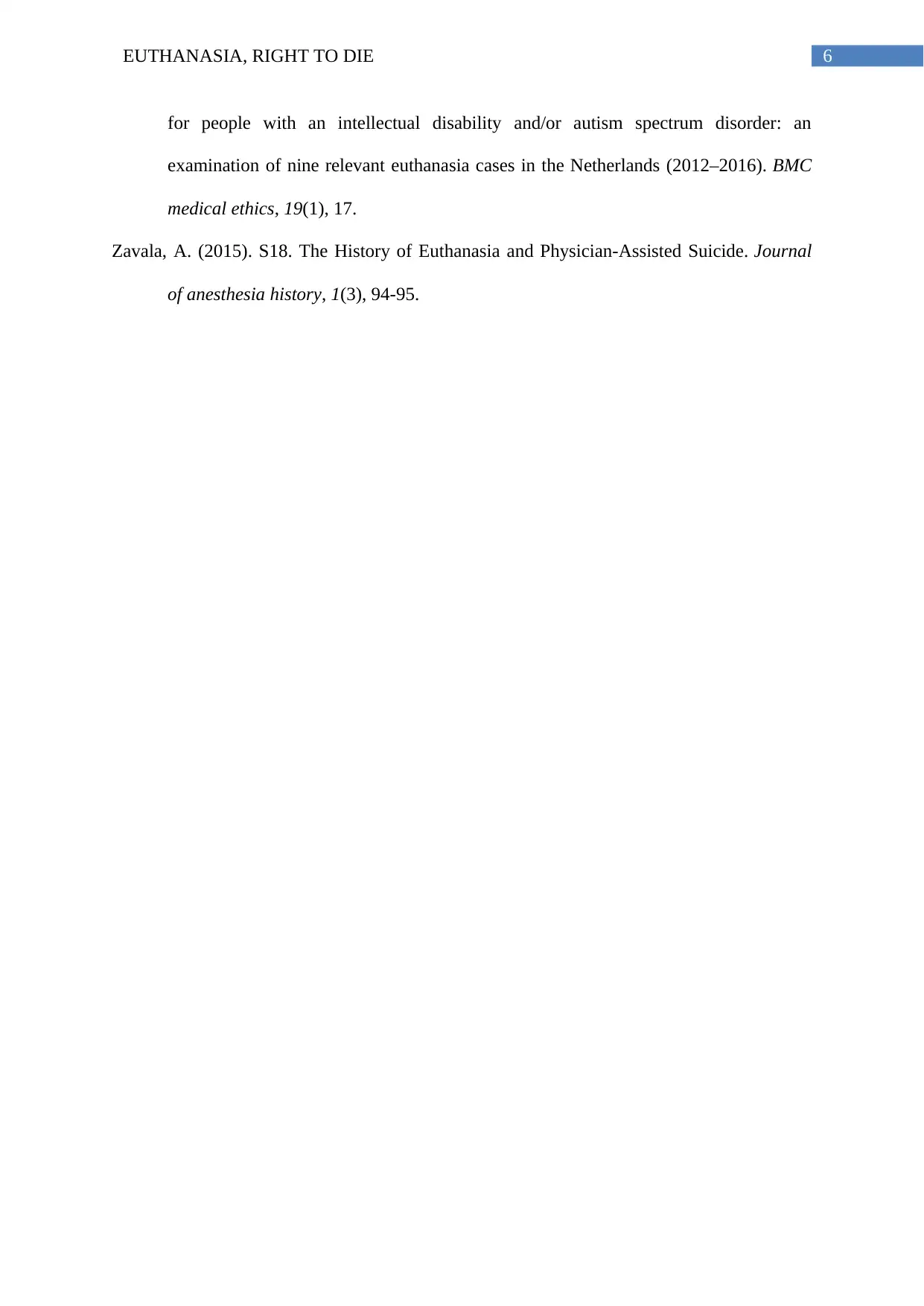
6EUTHANASIA, RIGHT TO DIE
for people with an intellectual disability and/or autism spectrum disorder: an
examination of nine relevant euthanasia cases in the Netherlands (2012–2016). BMC
medical ethics, 19(1), 17.
Zavala, A. (2015). S18. The History of Euthanasia and Physician-Assisted Suicide. Journal
of anesthesia history, 1(3), 94-95.
for people with an intellectual disability and/or autism spectrum disorder: an
examination of nine relevant euthanasia cases in the Netherlands (2012–2016). BMC
medical ethics, 19(1), 17.
Zavala, A. (2015). S18. The History of Euthanasia and Physician-Assisted Suicide. Journal
of anesthesia history, 1(3), 94-95.
1 out of 7
Related Documents
Your All-in-One AI-Powered Toolkit for Academic Success.
+13062052269
info@desklib.com
Available 24*7 on WhatsApp / Email
![[object Object]](/_next/static/media/star-bottom.7253800d.svg)
Unlock your academic potential
Copyright © 2020–2025 A2Z Services. All Rights Reserved. Developed and managed by ZUCOL.




